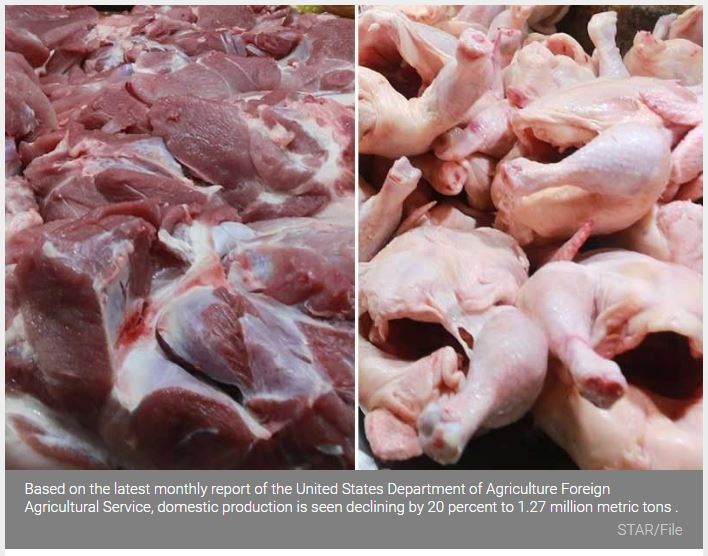Philippines: Pork, chicken production to drop this year
MANILA, Philippines — The Philippines is expected to see a huge drop in local pork and chicken production this year as the African swine fever (ASF) remains a concern and demand is still weak.
Based on the latest monthly report of the United States Department of Agriculture (USDA) Foreign Agricultural Service, domestic production is seen declining by 20 percent to 1.27 million metric tons .
“ASF continues to affect the main hog producing areas in Luzon. Supply problem may persist until 2021 despite some hog producers reporting the start of repopulation efforts,” the USDA said.
“Production recovery in 2021 is likely to be gradual and not reach 2019 levels as parts of the country continue to deal with the challenges of ASF,” it said.
Consumption has dropped by as much as 30 percent, but is expected to slowly improve as more provinces shift to the modified general community quarantine which has fewer restrictions placed on restaurants.
According to the USDA, unemployment has improved with the loosening of restrictions and is now at around 10 percent, which should contribute to improved demand in the remaining months of the year.
The USDA also lowered its pork import projection for the Philippines to 150,000 MT, down 32 percent from last year’s 222,000 MT.
“High global pork prices due to tight pork supplies may temper the rise in imports. Prices may face additional upward pressure with the recent ASF case in Germany, a major global supplier,” the USDA said.
“Cold storage capacity has returned to normal levels, which may have initially caused some traders to delay purchases from abroad. Imports of pork will likely start ramping
up in the third quarter in time for the holiday season, which is traditionally the heaviest consumption period,” it said.
USDA expects imports to rise next year as demand for meat and other food products improves.
Local production of chicken is projected to decrease by 14 percent to 1.25 million MT while domestic consumption is also expected to decline by 11 percent as the six-month lockdown in the country has heavily affected the hotel, restaurant, and institutional industry, where it is estimated that one third of all chicken is consumed.
Job losses and work closures have also contributed to lower consumer spending, particularly for food consumed outside the home.
“Although the food service sector is gearing back up with the loosening of quarantine restrictions, they are still operating at reduced capacity and their customers are feeling the effects of the economic downturn,” USDA said.
As for trade, Philippine chicken imports will likely rise by 2.5 percent to 375,000 MT this year, as mechanically deboned meat has proven to be a pantry staple and emergency relief item during the pandemic.
“Due to increased availability of cold storage space as inventory returned to normal levels, the gradual reopening of the economy, and the coming increase in holiday season demand, traders are looking to import more in the second half of the year,” USDA said.
“Imports in 2021 are expected to reach a similar level as 2020, supplementing local production that will recover partially but not reach 2019’s level,” it further said.
Source: https://www.philstar.com/business/2020/09/23/2044369/pork-chicken-production-drop-year


 English
English




